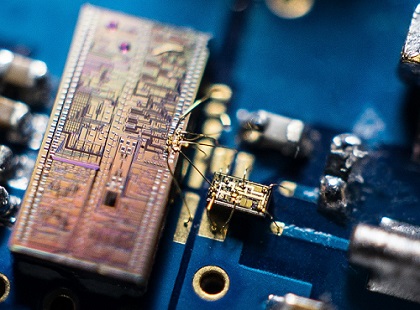Researchers from the University of Bristol have claimed a new record for detecting squeezed light, using a newly developed balanced homodyne detector. The work could pave the way for higher-performance quantum computers and quantum communications.
The device is based on two silicon photodiodes working in tandem to measure the properties of squeezed quantum light at high speeds. The device is engineered for ultralow electronic noise to detect the faint features of quantum light. It has a footprint of less than a square millimeter which, according to co-lead author Jonathan Frazer, contributes to its ability to measure at such high speeds.

The integrated detector combines a silicon photonic chip with a silicon microelectronics chip, yielding advanced speed in detecting quantum light. Courtesy of the University of Bristol.
“The scale of the detector is so important here as the system is very sensitive to limitations in speed and noise that arise from things like the layout of components on a PCB or the size of a photodiode,” Frazer told Photonics Media. “These ‘parasitics’ are reduced in both the photonic and amplification stages due to the submillimeter size and really demonstrate the potential of chip-scale integration in quantum photonics.”
Previous detectors have been limited in their ability to measure high speeds due to electronic noise, typically about one thousand million cycles per second.
“This has a direct impact on the processing speed of emerging information technologies such as optical computers and communications with very low levels of light. The higher the bandwidth of your detector, the faster you can perform calculations and transmit information,” Frazer said.
The detector has so far been clocked at an order of magnitude faster than what was previously regarded as state of the art, the researchers said, and the team is working on refining the technology to operate at even faster speeds.
“Squeezed light is a quantum effect that is very useful,” said co-lead author Joel Tasker. “It can be used in quantum communications and quantum computers and has already been used by the LIGO and Virgo gravitational wave observatories to improve their sensitivity, helping to detect exotic astronomical events such as black hole mergers. So improving the ways we can measure it can have a big impact.”
Much of the focus in terms of quantum photonics integration onto a chip to demonstrate scalable manufacture has been on the quantum part of the equation, said Jonathan Matthews, associate professor of quantum technology and director of the project. The current work, he said, has focused on the integration of the interface between quantum photonics and electronic readout.
“This is needed for the whole quantum architecture to work efficiently,” Matthews said. “For homodyne detection, the chip-scale approach results in a device with a tiny footprint for mass-manufacture, and importantly it provides a boost in performance.”
The research was published in Nature Photonics (www.doi.org/10.1038/s41566-020-00715-5).